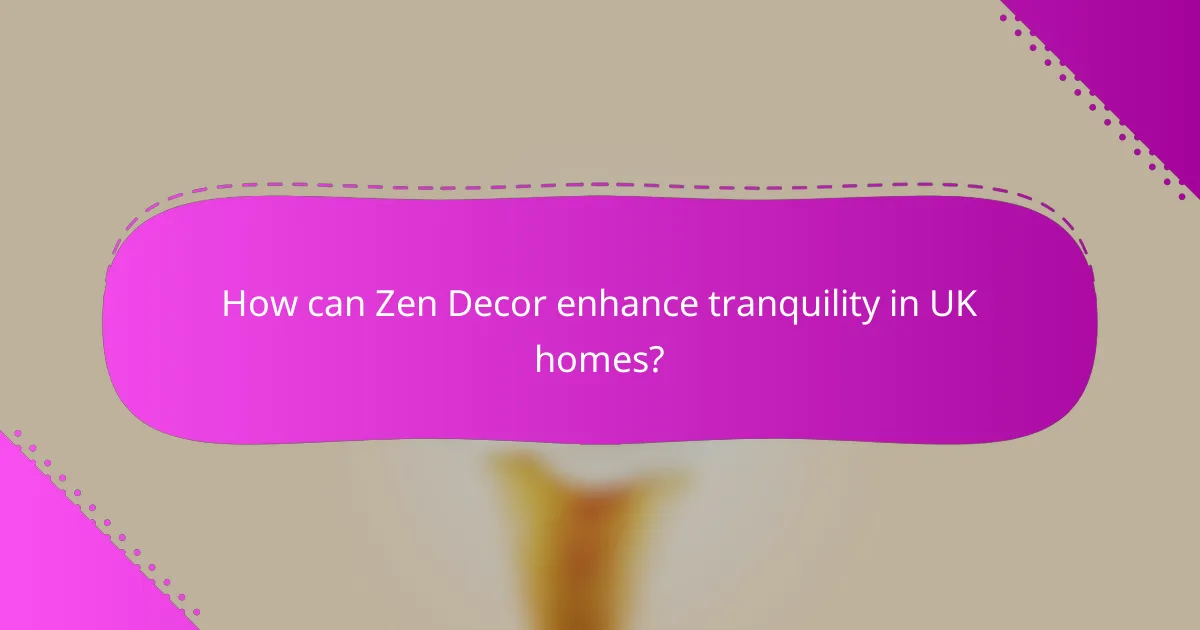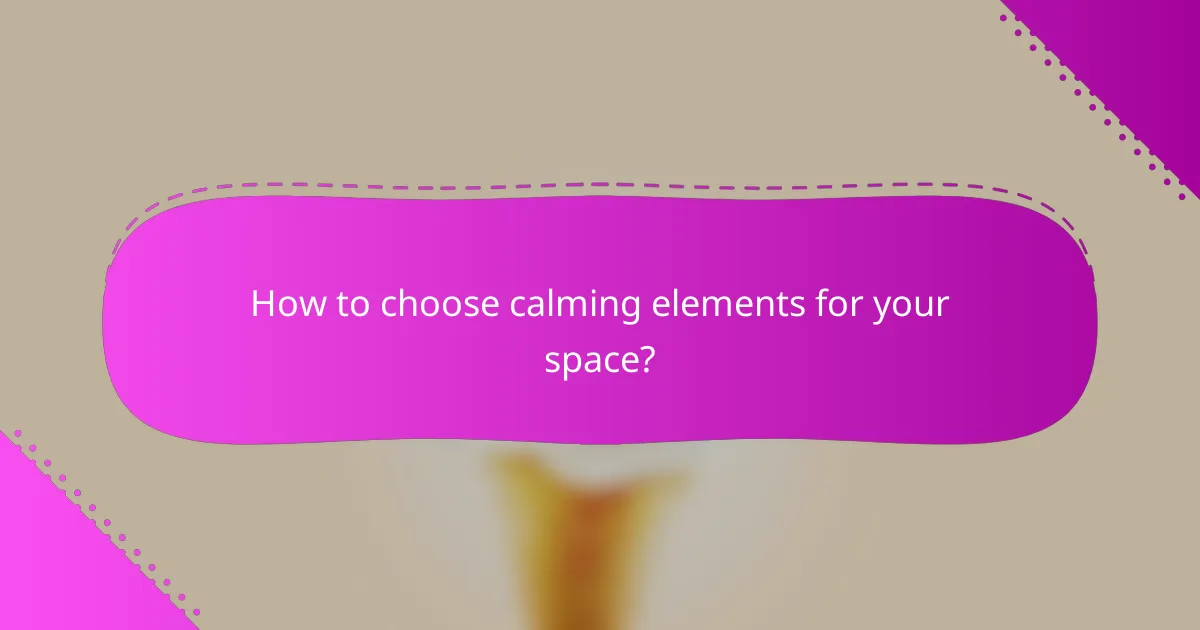Zen Decor transforms living spaces into serene retreats by emphasizing simplicity and natural materials that foster tranquility. Incorporating elements like bamboo, reclaimed wood, and stone not only enhances the aesthetic but also deepens the connection to nature, promoting relaxation and mindfulness. By thoughtfully selecting calming elements, you can create an environment that significantly reduces stress and nurtures overall well-being.

How can Zen Decor enhance tranquility in UK homes?
Zen Decor enhances tranquility in UK homes by creating a serene environment that promotes relaxation and mindfulness. By focusing on simplicity and natural elements, this style encourages a peaceful atmosphere that can reduce stress and improve overall well-being.
Incorporating calming colors
Calming colors play a vital role in Zen Decor, with soft hues like pale blues, greens, and neutral tones fostering a sense of peace. These colors can be used on walls, furnishings, and accessories to create a cohesive look that soothes the mind.
Consider using a monochromatic palette or subtle color variations to maintain a tranquil vibe. Avoid bold, bright colors that can be overstimulating and disrupt the calming atmosphere you aim to achieve.
Using natural materials
Natural materials such as wood, stone, and bamboo are essential in Zen Decor, as they connect the indoor space with the natural world. Opt for furniture and decor made from sustainably sourced materials to enhance the organic feel of your home.
Incorporate textures like woven fabrics and unpolished surfaces to add depth and warmth. This approach not only promotes tranquility but also supports eco-friendly practices, which are increasingly valued in the UK.
Creating open spaces
Open spaces are fundamental to Zen Decor, allowing for fluid movement and a sense of freedom. Aim to declutter your home by minimizing unnecessary items and furniture, which can create a more spacious and calming environment.
Use furniture that serves multiple purposes and arrange it to facilitate easy navigation. This layout not only enhances tranquility but also encourages a more mindful lifestyle by reducing distractions.
Integrating plants
Integrating plants into your decor brings life and a sense of calm to your home. Choose low-maintenance indoor plants like snake plants or peace lilies, which can thrive in various lighting conditions and improve air quality.
Position plants in natural light and consider grouping them in clusters to create a serene focal point. Their presence can significantly enhance the tranquility of your space, making it feel more connected to nature.
Utilizing soft lighting
Soft lighting is crucial for creating a calming atmosphere in Zen Decor. Use warm-toned bulbs and consider dimmable fixtures to adjust the brightness according to the time of day and your mood.
Incorporate various light sources, such as floor lamps, table lamps, and candles, to create layers of light. This approach helps to reduce harsh shadows and create a soothing ambiance that promotes relaxation in your UK home.

What are the best natural materials for Zen Decor?
The best natural materials for Zen decor include bamboo, reclaimed wood, stone, and cotton. These elements promote tranquility and a connection to nature, essential for creating a calming environment.
Bamboo for flooring
Bamboo is an excellent choice for flooring due to its sustainability and durability. It grows quickly and can be harvested without damaging the ecosystem, making it an eco-friendly option.
When selecting bamboo flooring, consider the finish and color that best complements your space. Light tones can enhance a sense of openness, while darker shades may add warmth and coziness.
Reclaimed wood for furniture
Reclaimed wood furniture adds character and history to your Zen space. Sourced from old buildings or furniture, this material not only reduces waste but also brings unique textures and colors.
Look for pieces that showcase the natural imperfections of the wood, as these features contribute to a rustic, calming aesthetic. Ensure the wood is properly treated to avoid issues with pests or decay.
Stone for accents
Incorporating stone accents can enhance the natural feel of your decor. Options like slate, granite, or river stones can be used for tabletops, wall features, or decorative elements.
Choose smooth, polished stones for a more refined look or rough, textured stones for a rustic vibe. Consider the color palette of your space to ensure the stones harmonize with other materials.
Cotton for textiles
Cotton is a versatile and breathable fabric ideal for textiles in Zen decor. It can be used for cushions, curtains, and throws, adding comfort and softness to your environment.
Opt for organic cotton to ensure a chemical-free option that aligns with the principles of natural living. Light, neutral colors can promote a serene atmosphere, while subtle patterns can add visual interest without overwhelming the space.

How to choose calming elements for your space?
To choose calming elements for your space, focus on simplicity, natural materials, and personal significance. These factors contribute to a tranquil atmosphere that promotes relaxation and mindfulness.
Prioritizing simplicity
Simplicity is key in creating a calming environment. Aim for a minimalist approach by reducing clutter and selecting a few essential pieces that resonate with you. This not only enhances the aesthetic but also allows for a more peaceful state of mind.
Consider using neutral colors and clean lines in your furniture and decor. Soft whites, beiges, and muted tones can help create a serene backdrop, while avoiding overwhelming patterns or bold colors that may disrupt tranquility.
Focusing on texture
Texture adds depth and interest to a calming space. Incorporate natural materials like wood, stone, and textiles to create a tactile experience that soothes the senses. For example, a soft wool throw or a rough-hewn wooden table can evoke comfort and warmth.
Mixing different textures can enhance the overall ambiance. Combine smooth surfaces with rough ones, such as pairing a sleek glass vase with a woven basket, to create a balanced and inviting atmosphere.
Selecting meaningful decor
Choosing decor that holds personal significance fosters a deeper connection to your space. Select items that evoke positive memories or emotions, such as photographs, artwork, or souvenirs from meaningful experiences. This personal touch can enhance the sense of tranquility.
Be mindful of the stories behind your decor. Instead of filling your space with generic items, opt for pieces that reflect your values and interests. This approach not only creates a calming environment but also makes your space uniquely yours.

What are effective Zen Decor styles in the UK?
Effective Zen decor styles in the UK focus on creating a serene and calming atmosphere through simplicity and natural elements. These styles emphasize minimalism, organic materials, and a connection to nature, promoting tranquility in living spaces.
Japanese Zen style
Japanese Zen style is characterized by its emphasis on simplicity, natural materials, and a harmonious relationship with nature. Key elements include tatami mats, shoji screens, and low furniture, which create an open and uncluttered environment.
To achieve this look, consider using neutral color palettes, incorporating indoor plants, and selecting handcrafted items that reflect traditional Japanese craftsmanship. Avoid overcrowding spaces; instead, focus on a few meaningful pieces that evoke calmness.
Scandinavian minimalism
Scandinavian minimalism blends functionality with aesthetic simplicity, making it a popular choice for Zen decor. This style features clean lines, light colors, and an abundance of natural light, which contribute to a tranquil atmosphere.
Incorporate elements like wooden furniture, soft textiles, and minimalistic decor to create a cozy yet uncluttered space. Prioritize quality over quantity; choose a few well-designed items that enhance the overall serenity of the room.
Modern organic design
Modern organic design focuses on integrating natural forms and materials into contemporary spaces, promoting a sense of calm and connection to the environment. This style often includes earthy tones, organic shapes, and sustainable materials like reclaimed wood and natural fibers.
To implement this style, select furniture and decor that mimic natural forms, such as curved lines and asymmetrical shapes. Use a mix of textures to create depth while maintaining a cohesive and peaceful aesthetic. Aim for a balance between modernity and nature to enhance the tranquil ambiance.
